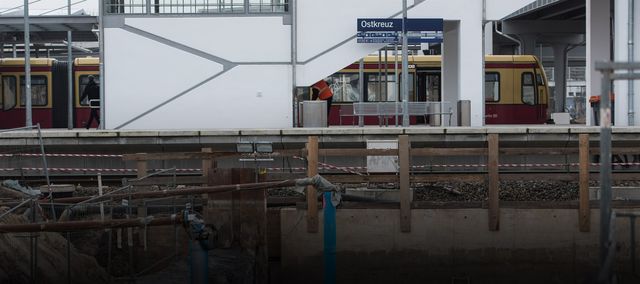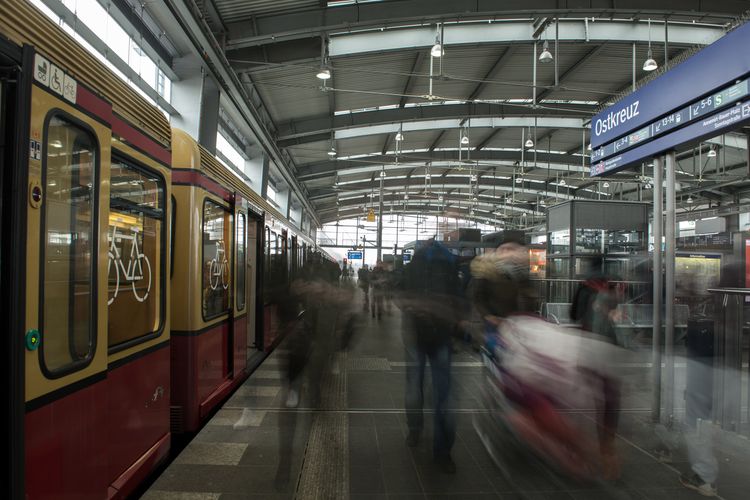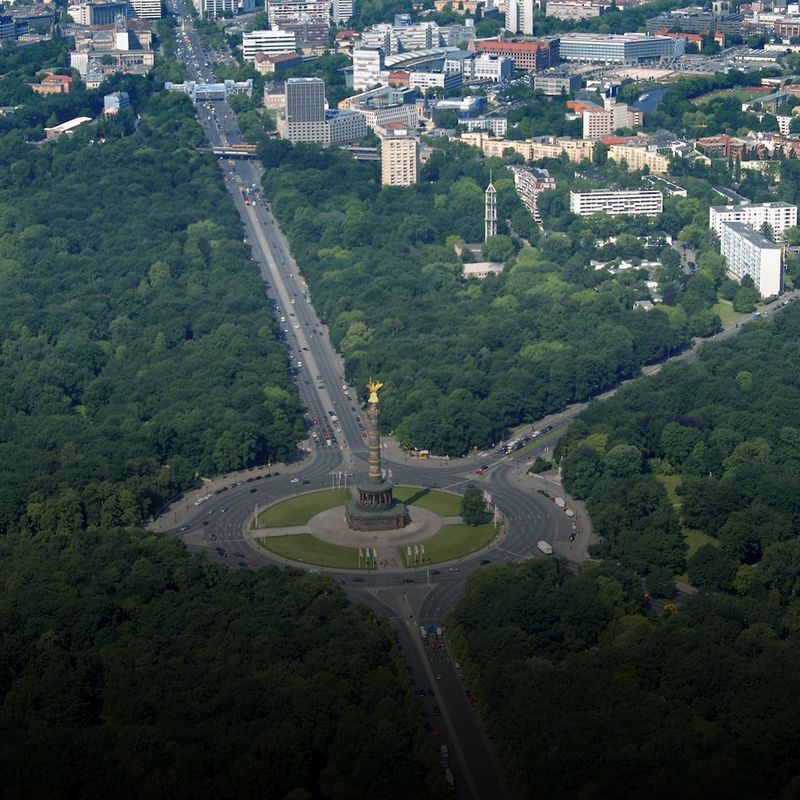8 March 2018
In construction projects such as the Tiergarten tunnel, Berlin’s new central station, the Government district and the extension of underground line 5 to create what has become known as the “Kanzlerbahn”, or “Chancellor’s line”, it’s the job of the geologists and hydrologists of TÜV NORD subsidiary DMT to maintain a consistent groundwater level. For this, they collect, monitor and analyse data. All for the sake of protecting people and nature. The groundwater managers are currently being kept busy by the major building site at Berlin’s Ostkreuz.
Anyone changing local trains at Berlin Ostkreuz just a few years ago would have felt like they had landed up at the terminus of some forgotten suburb. A rusty roof covered a draughty platform with wild growths of dandelions, grass and shrubs at one end. Now, by way of contrast, a modern hall reminiscent of Berlin’s central station arches up into the sky. Since 2015, regional trains have also been stopping at a newly laid platform. These were joined in 2017 by the Intercity express between Cottbus and Norddeich, which began calling in at Ostkreuz for the first time that year. And the old “Rostkreuz” – as Berlin wags sardonically christened the train station in a play on words on the German word for “rust” - has now blossomed into one of the largest transport hubs in Germany. 100,000 passengers embark, disembark and change trains here every day.
© Stefanie LoosFrom “Rostkreuz” to transport hub: 100,000 passengers now embark, disembark or change trains every day at Berlin Ostkreuz station.
Water management at Ostkreuz
Building work has been ongoing since 2006 to make the station fit for the future. And the station has remained open throughout, since to close it would plunge the whole of Germany into transport chaos. But if such a huge project is to proceed smoothly – without harming the environment – builders, structural engineers and architects versed in their work are just the start of it: underground engineering work at the Ostkreuz construction site is supervised by geologists and hydrologists to ensure – quite literally – that nothing goes down the drain.
© Stefanie LoosMarch of the water: 4.36 million cubic metres of groundwater need to be pumped out of the ground over the entire period of construction at Ostkreuz.
During a site inspection, Matthias Krienert explains: “This is where you would normally expect the groundwater to be.” As he speaks, the geologist in charge of water management at Ostkreuz for TÜV NORD subsidiary DMT points out the edge of a section of broken wall that is visible one and a half metres below ground at the edge of the excavation pit. Six wells sunk into the ground along the long sides of the pit ensure at the same time that the Ostkreuz construction workers don’t need life jackets to work in the roughly four-meter-deep pit. Their job is to pump the groundwater out of the ground. 80 cubic metres per hour - enough to 666 bathtubs or to meet the annual requirement of a two-person household. 4.36 million cubic metres of water need to be extracted from the ground over the entire construction period using such dewatering wells to ensure that the new station is built on solid foundations.
Is everything as it should be?
It’s the job of Matthias Krienert and his colleagues from DMT to ensure that the trees in the neighbouring park don’t go short of water and that the surrounding houses along Sontagsstrasse are not affected. They do what is necessary to make sure that the water table doesn’t drop too far. After all, an overly rapid fall in the groundwater level would increase the risk to people and nature - particularly in a city like Berlin, which is literally built on sand. If too much water is extracted from soil consisting of sand and clay, the soil can shrink and, in the worst-case scenario, give way completely.
© Stefanie LoosModelling reality: Geologists can use flow models to predict how the groundwater level will be changed by drainage - and counteract those changes using infiltration wells.
Builders therefore need to meet strict requirements if they are planning to lower the groundwater level. If the water table should sink by 30 cm in built-up areas, the houses need to be checked for cracks in their external walls. Increase that reduction to half a metre, and inspections of the inside of the apartments become necessary. Such is the directive laid down by the Berlin water authorities. The further the reduction in groundwater levels encroaches into residential areas, the higher the costs for the builders - and the greater the risk to the houses.
Water management on construction sites requires a high degree of finesse: Precise calculations are needed to ensure that the infiltration systems feed enough water back into the groundwater to prevent it from sinking to a critically low level. Enough, but no more than necessary: Otherwise, the residents of the district will suddenly find their cellars full of water. “We also have to respond quickly to the vagaries of the weather.” When, for example, a once-in-a-century rainfall event in June 2017 transformed the streets of Berlin into rivers and flooded the underground stations, Krienert did not hesitate for a moment before switching off the infiltration systems.
The groundwater flow model
“Here you can see how the groundwater level changes,” says Matthias Krienert, tapping on an open map. What look like topographic contour lines superimposed on a map of the Friedrichshain district are the result of a simulation based on a groundwater flow model developed by DMT. Rather than being contour lines, these are actually the pathways taken by the groundwater when it is extracted at another site. “With this kind of model you can make things visible that are virtually impossible to calculate analytically,” says Krienert enthusiastically. First of all, the geologists review the calculations of the contractor on the basis of their own models. They then develop solutions to reduce the area affected by groundwater reductions to the absolute minimum. To do so, they rely on infiltration wells. The water pumped out of the earth on the building site is redirected back into the earth a few hundred metres away. This is more sustainable than pumping the water into the river Spree, And, at the same time, is a good way of compensating for the reduction in the water table. With their model, the geotechnologists can also predict where these infiltration wells are needed and how many are required to ensure that the reduction in the groundwater level is localised as far as possible.
© Stefanie Loos40 monitoring stations measure the groundwater level every minute. In this way, the geologists from DMT can see at a glance Whether the water table is as it should be or there are anomalies that require a response.
During the tour, Matthias Krienert and his colleague Timo Hackmann show how measuring stations precisely record the level of groundwater from one minute to the next. The measuring stations are concealed underneath discreet street-level caps, as can be seen here at the edge of the little Annemirl-Bauer Platz. Every minute, an automatic data logger records the groundwater level. 40 of these measuring stations have been set up by the experts at the corner points of the area of groundwater drainage. They collect the data once a week and feed them into their evaluation software back in the office. This shows them whether the groundwater level is where it should be, whether there are deviations, and if the causes of such deviations need to be reviewed and countermeasures initiated.
© Stefanie LoosGeologist Matthias Krienert (r.) has been working as a project manager for DMT for 17 years. With his colleague Timo Hackmann, who started his career at DMT after completing a degree in geotechnology.
Experience with the Berlin underground for decades
A daily challenge. After all, where the engineers can rely on the regulations governing the use of steel and concrete in their plans for the railway station concourse, it is experience that plays a major role in geology. “The material we work with changes from one metre to the next,” says Krienert. If the soil is thicker on one side of the excavation pit than the other, this changes the speed at which the water flows and seeps away. The experts therefore have to rely on their many decades of experience with Berlin's underground railway system, which they incorporate into their models. With each construction site, they learn more about the local soil conditions and can make further refinements to their model. It's a lucky break for the builders that the experts from DMT been gathering experience of the soil of Berlin since the 1990s.
You may also like
Good to know
Dewatering wells such as those in use at Ostkreuz and other building sites draw in groundwater from a great distance; complex filters made of gravel layers ensure that no soil is flushed out in the process. What you end up with is a funnel with the excavation pit as its deepest point. Infiltration wells are used to raise the water table again – to ensure that it does not fall below a critical level.
DMT
TÜV NORD subsidiary DMT is one of the leading providers of natural resources exploration, mining and coking plant engineering, construction and infrastructure, product testing and building security, as well as industrial testing and measurement technology. In civil engineering projects such as that taking place at Berlin Ostkreuz, its staff use their many years of expertise in geotechnical engineering to investigate, monitor and assess the subsoil and groundwater conditions.







